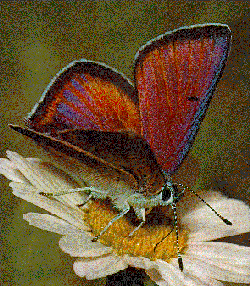 Insects in the Big Picture
Insects in the Big Picture
About 150,000 species of those insects which brighten our summers have been found. The moths and butterflies generally have larger wings, in proportion to body size, than the other insects. The distinction between butterflies and moths is not always clear, but two rules apply to most species:
The Lepidoptera ('lepido-ptera' = 'scaly-wings') have the most spectacular-looking larvae:
caterpillars. They can be fuzzy, long-haired, smooth, large, small, poisonous,fat or skinny, and live
to eat. They spend all of their time eating up to tens of thousands of times their own weight.

 Insects in the Big Picture...2.4, March 1996
Insects in the Big Picture...2.4, March 1996